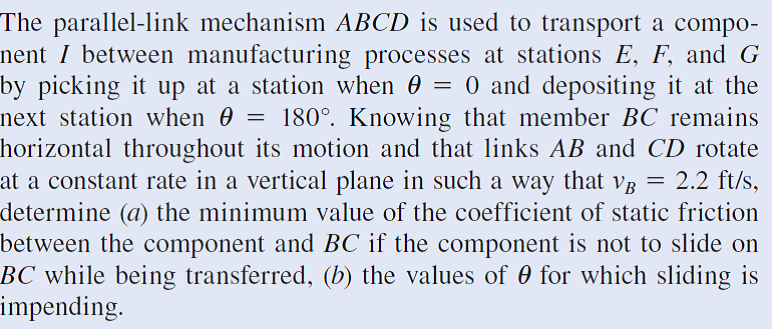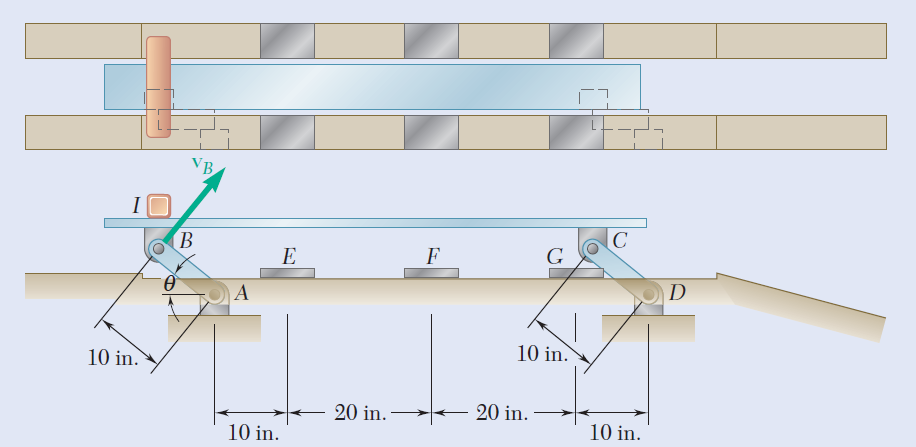The parallel-link mechanism ABCD is used to transport a compo- nent I between manufacturing processes at stations E, F, and G by picking it up at a station when 0 = 0 and depositing it at the next station when 0 = 180°. Knowing that member BC remains horizontal throughout its motion and that links AB and CD rotate at a constant rate in a vertical plane in such a way that vg determine (a) the minimum value of the coefficient of static friction between the component and BC if the component is not to slide on BC while being transferred, (b) the values of 0 for which sliding is impending. 2.2 ft/s, VB B. Ө 10 in. 10 in. 20 in. 20 in. 10 in. 10 in.
The parallel-link mechanism ABCD is used to transport a compo- nent I between manufacturing processes at stations E, F, and G by picking it up at a station when 0 = 0 and depositing it at the next station when 0 = 180°. Knowing that member BC remains horizontal throughout its motion and that links AB and CD rotate at a constant rate in a vertical plane in such a way that vg determine (a) the minimum value of the coefficient of static friction between the component and BC if the component is not to slide on BC while being transferred, (b) the values of 0 for which sliding is impending. 2.2 ft/s, VB B. Ө 10 in. 10 in. 20 in. 20 in. 10 in. 10 in.
Elements Of Electromagnetics
7th Edition
ISBN:9780190698614
Author:Sadiku, Matthew N. O.
Publisher:Sadiku, Matthew N. O.
ChapterMA: Math Assessment
Section: Chapter Questions
Problem 1.1MA
Related questions
Question
Knowing that the coefficients of friction between the component I and member BC of the
Reference to Problem 12.62:

Transcribed Image Text:The parallel-link mechanism ABCD is used to transport a compo-
nent I between manufacturing processes at stations E, F, and G
by picking it up at a station when 0 = 0 and depositing it at the
next station when 0 = 180°. Knowing that member BC remains
horizontal throughout its motion and that links AB and CD rotate
at a constant rate in a vertical plane in such a way that vg
determine (a) the minimum value of the coefficient of static friction
between the component and BC if the component is not to slide on
BC while being transferred, (b) the values of 0 for which sliding is
impending.
2.2 ft/s,

Transcribed Image Text:VB
B.
Ө
10 in.
10 in.
20 in.
20 in.
10 in.
10 in.
Expert Solution
This question has been solved!
Explore an expertly crafted, step-by-step solution for a thorough understanding of key concepts.
This is a popular solution!
Trending now
This is a popular solution!
Step by step
Solved in 4 steps with 10 images

Knowledge Booster
Learn more about
Need a deep-dive on the concept behind this application? Look no further. Learn more about this topic, mechanical-engineering and related others by exploring similar questions and additional content below.Recommended textbooks for you

Elements Of Electromagnetics
Mechanical Engineering
ISBN:
9780190698614
Author:
Sadiku, Matthew N. O.
Publisher:
Oxford University Press

Mechanics of Materials (10th Edition)
Mechanical Engineering
ISBN:
9780134319650
Author:
Russell C. Hibbeler
Publisher:
PEARSON

Thermodynamics: An Engineering Approach
Mechanical Engineering
ISBN:
9781259822674
Author:
Yunus A. Cengel Dr., Michael A. Boles
Publisher:
McGraw-Hill Education

Elements Of Electromagnetics
Mechanical Engineering
ISBN:
9780190698614
Author:
Sadiku, Matthew N. O.
Publisher:
Oxford University Press

Mechanics of Materials (10th Edition)
Mechanical Engineering
ISBN:
9780134319650
Author:
Russell C. Hibbeler
Publisher:
PEARSON

Thermodynamics: An Engineering Approach
Mechanical Engineering
ISBN:
9781259822674
Author:
Yunus A. Cengel Dr., Michael A. Boles
Publisher:
McGraw-Hill Education

Control Systems Engineering
Mechanical Engineering
ISBN:
9781118170519
Author:
Norman S. Nise
Publisher:
WILEY

Mechanics of Materials (MindTap Course List)
Mechanical Engineering
ISBN:
9781337093347
Author:
Barry J. Goodno, James M. Gere
Publisher:
Cengage Learning

Engineering Mechanics: Statics
Mechanical Engineering
ISBN:
9781118807330
Author:
James L. Meriam, L. G. Kraige, J. N. Bolton
Publisher:
WILEY